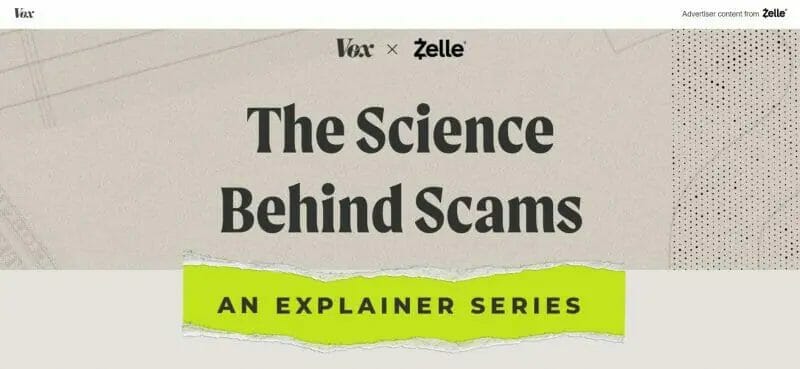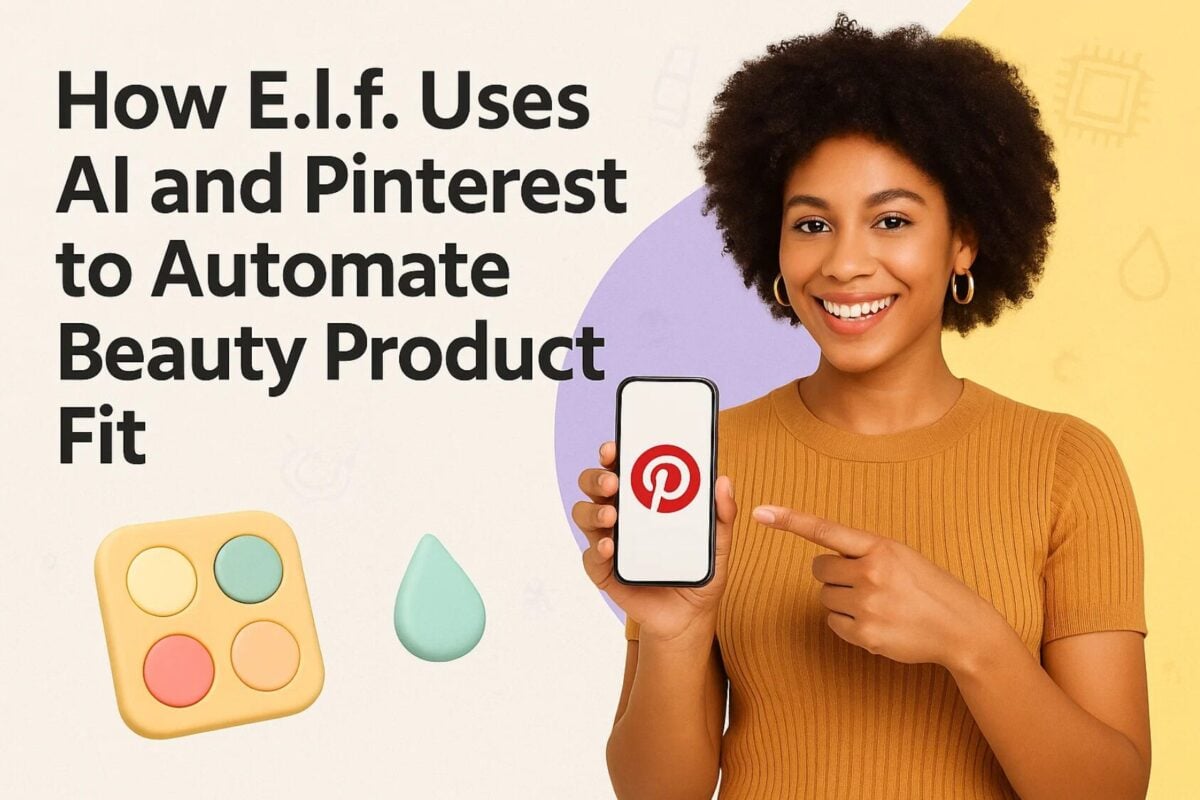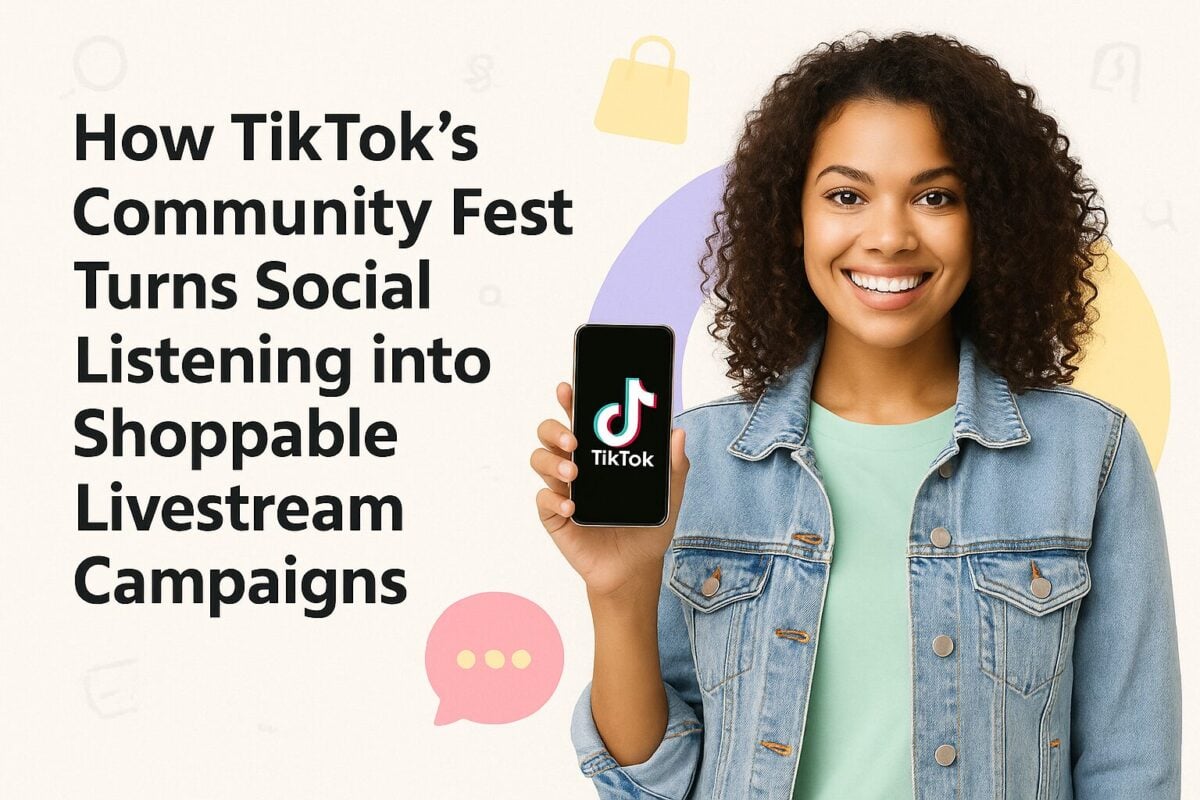Branded content is 22x more engaging than display ads and other types of advertisements. Why? Because it tells a story, creates an emotional connection with the audience, and feels more authentic than your typical commercial.
However, there is an art to creating branded content. And that’s why you’re here—because you’re interested in learning more about branded content, what it is, why it’s so beneficial, and, more than anything else, how to create top notch branded content.
Let’s get started.
What is Branded Content?
Branded content is a marketing strategy that involves creating and sharing content across several media that discuss your brand’s values and mission, often evoking emotions in your viewers or readers.
An example of branded content is the partnership between media company Vox and money transferring app Zelle “The Science Behind Scams.” Using Vox’s platform and Zelle’s financial savviness, they created a branded educational series helping their audiences avoid costly scams.

Source: voxmedia.com
While still promoting their brands, they were able to create content that doesn’t talk about their product or service, but instead teaches their audiences about something important—both to their audiences and their brands.
Branded Content vs. Content Marketing
In just a few words, branded content is one facet of an overall content marketing strategy. Content marketing, however, still includes highly promotional and product-centric content, like knowledge bases and content sharing product updates.
However, brands should also include a section of their content marketing strategy that focuses exclusively on creating and distributing branded content as yet another way to get their brand’s name out there—without being overly promotional.
Benefits of Branded Content
Branded content is very different from traditional advertising, and statistics show that it’s much more effective. With stats showing us that branded content generates 59% more brand recall than other digital ads and that it elicits a 62% more positive response than commercials, there are several obvious benefits to this strategy.
However, that’s not all. We’ve got four major benefits that you need to keep in mind when deciding whether or not to invest in branded content. (Although with 74.5% of marketers including branded content in their content campaigns, you’ll be the odd man out if you don’t.)
It’s authentic
One of the biggest reasons to use branded content is because it’s one of the more authentic types of content to share with your audience. It’s always about sharing your brand’s mission, whether it’s body positivity, financial advice, wanderlust, etc.
It easily appeals to others interested in these topics without being promotional or invasive. The key here is that you don’t want your branded content to just “appear” non promotional—the goal is to keep it completely non promotional.
By creating authentic and noninvasive content, you’re simply resonating with or educating your audience while simultaneously building an emotional connection. Those that enjoy your branded content will automatically start gravitating towards your brand when they actually need your products or services.
It creates a story about the brand and not its products or services
Your branded content is never about your products and services. Instead, it focuses on issues in your industry, educational tips, or even just fun lifestyle content that appeals to your target audience.
For example, energy drink Red Bull does a great job of creating lifestyle branded content surrounding adventures and sports. By doing this, they’re connecting with their target audience about something other than their product.
This strategy helps create a story around your brand and is a compelling form of native advertising. Stop talking about your product. Start finding common ground with your audience and build your story that way.
It has viral potential
Certain branded content formats tend to lend more virality to the piece of content. For example, a TikTok or short-form YouTube video, a meme, an Instagram post, etc., are all quick bites of content that have major potential to go viral.
It builds a stronger relationship between your brand and your customer
The entire point of branded content is to create content that resonates with your customer. It builds an emotional connection. It helps them sympathize with your brand. It excites them and makes them want to support your business through their own purchases and by referring you to their friends and family.
How to Create Your Own Branded Content
Now that you know the importance and benefits of creating branded content, it’s time to learn how to get started with this marketing strategy. Let’s walk through step-by-step how you can take advantage of this type of content.
1. Brainstorm ideas
The first step is to brainstorm ideas for your branded content. How can you best support and resonate with your target audience?
A few ideas to consider are:
- Creating an educational online course
- Putting together an organic user-generated content campaign with influencers
- Filming a video series with strategic product placement throughout
- Building a campaign surrounding a social cause your brand supports
- Designing a series of memes that poke fun at something your audience will appreciate
There are endless possibilities; these are only a few ideas. Essentially, the point is to create content that your brand publishes but that isn’t focusing on your actual product or service. Instead, the content should be relevant to your industry or your target audience’s interests. But by having your brand name attached to it, you’re helping to facilitate that deeper connection.
2. Sketch out a storyboard or outline
Once you have your idea, it’s time to flesh it out. This will keep you organized as you build out your branded content campaign.
If you’re planning on creating a branded video marketing campaign, you’ll want to start by creating a storyboard. This will help you sketch out your video ideas scene by scene, ensuring you cover everything you’re aiming to cover.
Utilize a storyboard template like the one below:

Source: steemit.com
Whether you create editorial content that you plan on inserting strategic product placement, an educational video series, or a series of short-form, humorous videos, a storyboard is a must.
If you’re planning on creating a course or a series of educational articles, you’ll need to start with an outline. Create a Google Doc and start outlining each of the chapters or articles you want to cover.
You can also take advantage of project management software to help manage this process. This can be a great way to map out your influencer campaigns, meme generation, or social cause campaign.
3. Use the right tools
Once you’ve fully fleshed out your idea and you know what type of content you’re going to create and what you’re going to cover, it’s time to look into tools to help you get started. We’re going to walk through various tools and companies that can help with the different types of branded content campaigns you might be considering.
Influencer marketing campaigns
Working with influencers to create authentic user-generated content is a great idea for your next branded content campaign. But it can be a process, which is why using the right tools to find, hire, and manage your influencer partners can be a major help.
Biteable makes it easy to create short videos to share on social media. Use this as a way to promote your new series, or use this tool to create Reels, TikTok, Stories, and other short videos as a social media branded content campaign. Promo is another tool with video templates and design elements that makes creating short-form and social media tools easy and affordable. Access stock video clips as well if you don’t have the tools to film your own videos. Premiere Pro is a video editing tool when you’ve recorded your own video footage and need to turn it into a video that tells a story. Upload your video footage to Premiere Pro, piece it together, add in special effects, then download and get ready to share. Creating memes is another great way to promote authentic and humorous content that your audience will thoroughly enjoy. Whether you repurpose existing memes to fit your industry or make your own, there are tools that can help. Memasik is a mobile app that you can use to create your own memes. Search for existing meme photos and add in your own caption with classic meme fonts. You can then download them right to your phone and share on social media or insert into your social media scheduling app. GIFS are also meme-like in nature, and you can even create your own GIFs to use in your marketing content. Turn video footage into a GIF with GIPHY, or search their massive library to find GIFs that will fit with your campaign. Many campaigns are graphic-centric. And many more simply need graphics to help visualize their messaging. Using graphic design tools can help you further tell your brand story. Canva is a quick and easy DIY graphic design tool with thousands of customizable templates. They also have a mobile app that makes it easy to create visuals on-the-go. Insert your brand fonts and colors to help make your graphics even more recognizable by your audience. Visme is another DIY graphic design and visual content tool. It can help you to create social media graphics, ebooks for branded content campaigns, presentations for your online courses, infographics, and more. Adobe has a number of graphic design tools available. Their DIY tool, Adobe Express, is a free and easy tool to use. Or, you can sign up for their Creative Cloud to gain access to more in-depth tools like Photoshop, Illustrator, and InDesign. If you’re creating an online course, you need to have the right platform to host it. You may have a developer create a platform in-house. But a more affordable and faster option is simply using one of these tools to help. Teachable is a platform that hosts your online course for you. Upload course videos, insert text for lessons, and even hold live sessions with course takers. If you so choose, Teachable also makes it possible to take payments for access to your course. Put together a full-fledged training course with Learnworlds. Upload ebooks, video lessons, assessments, certificates, and more. You can even create an interactive experience for your audience through this platform. Thinkific is another option for building and hosting your online course. With the option to fully customize your course’s front page, this is a great way to incorporate your branding and match it to your recognizable fonts and colors. CreatorIQ makes it easy to find, hire, pay, and manage your influencers and content creators. Whenever you work with influencers for a branded content campaign, consider trying out CreatorIQ to find the best fits for your brand. There are tools that can help you edit full-fledged videos and short films, and there are tools that can help you create short-form videos. Both are great to keep on hand whenever you’re running a video branded content campaign. Key Features: Search/Discovery, Automated Recruiting, Influencer Relationship Management, Content Review, Campaign Management, Campaign Reporting, Influencer Analysis, Audience Analysis, E-commerce Tools, Product/Gifting Tools, Forms and Compliance, Fake Follower/Fraud Detection, Payment Processing, Channels: Facebook, Instagram, Twitter, YouTube, Pinterest, Twitch, Blogs Aspire helps you find influencers that can create stunning branded content for your brand. Make the most out of your next user-generated content campaign by working with Aspire influencers and content creators. Read more about UGC and UGC agencies. Key Features: Search/Discovery, Influencer Relationship Management, Influencer Marketplace, Team Collaboration Tools, Content Review, Content Library, Campaign Management, Campaign Reporting, E-commerce Tools, Product/Gifting Tools, Forms and Compliance, Payment Processing, Social Listening, Competitor Research, Visual Discovery, Influencer Content Amplification, Channels: Instagram, YouTube, Facebook, Twitter, Pinterest, Blogs GRIN is an all-in-one influencer marketing and branded content creation platform. It helps you find content creators, put together contracts, manage the campaign, repurpose the content across platforms, analyze its performance, and more. Key Features: Content Amplification, Search/Discovery, Influencer Lifecycle Management, Influencer Relationship Management, Content Review, Content Library, Campaign Management, Campaign Reporting, Influencer Analysis, Audience Analysis, E-commerce Tools, Product/Gifting Tools, Forms and Compliance, Channels: Facebook, Instagram, TikTok, Twitter, Twitch, YouTube1. Biteable
2. Promo
3. Premiere Pro
Meme campaigns
4. Memasik
5. GIPHY
Graphic campaigns
6. Canva
7. Visme
8. Adobe
Online course campaigns
9. Teachable
10. Learnworlds
11. Thinkific
12. CreatorIQ
Video marketing campaigns
13. Aspire (formerly AspireIQ)
14. Grin
4. Publish
Once you’ve used your tools of choice to create your branded content, it’s time to publish. Share your branded content on social media, on your website, on your blog, on your YouTube channel, via your email newsletter, or anywhere else it makes sense.
While your branded content won’t be promotional in nature, there’s nothing wrong with promoting said branded content in order to reach as many people in your target audience as possible.
Create Your Own Branded Content Strategy Today
Start investing in branded content and propel your business forward. Discover even more ways to improve your content strategy and start reaching new audiences. Use your brand to tell a story, incorporate strategic product placement, and create branded content that doesn’t feel promotional.
Frequently Asked Questions
What does branded content mean?
Branded content is the process of creating marketing and advertising content that doesn’t feel like the customer is being marketed to. It’s about creating content that tells a story, that creates an emotional connection, that resonates with the target audience in order to build brand recognition and customer loyalty.
What is an example of branded content?
Examples of branded content include podcasts, blog content, YouTube videos, short films, user-generated content, and other types of content that aren’t meant to directly promote a brand and its products and services, but that do so simply by providing valuable and resonating content to their audience.
What is branded content on social media?
On social media, branded content might look like a YouTube series, educational Instagram Reels or TikTok videos, LinkedIn articles, and similar content that is useful and engaging for viewers but doesn’t outright promote the brand.
Why is branded content successful?
Branded content pulls on emotions more than regular promotional content does. It creates a connection between the customer and the brand, leading to better customer loyalty.
What is the difference between branded content and content marketing?
Branded content is just a single facet under the entire content marketing umbrella. Content marketing encompasses so much more than just branded content, including knowledge base articles, product updates, product-led content, tutorials and how-to’s, and more.






















